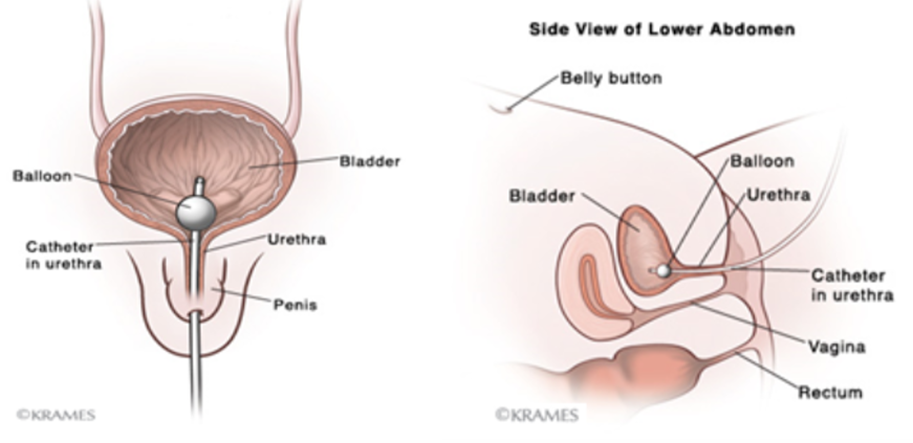Bacilus Calmette-Guerin (BCG) Therapy
What is BCG therapy?
Bacilus Calmette-Guerin (BCG) (pronounced “ba SIL us KAL met gay RAYN”) is an immunotherapy treatment. It is made from a bacteria called Mycobacterium bovis which stimulates your immune system to attack cancer cells.
How is BCG therapy given?
This
medication goes directly into your bladder through a urinary catheter (thin, flexible tube). This is called intravesical therapy.
How many BCG therapy treatments will I need?
You will start with one treatment a week for 6 weeks. This is called the induction phase.
After the induction phase, you will have 4 to 6 weeks of rest. During this time, you will not receive treatment. You will also have a cystoscopy to confirm no disease.
Six weeks after your last treatment, your provider will decide if you will continue with BCG maintenance therapy. If so, this is given once every 3 weeks.
How do I prepare for my treatment?
-
Please be on time for your appointment.
-
Do not drink any liquids for 4 hours before your BCG therapy appointment.
-
If you take a diuretic medication (“water pill”) and usually take it in the morning, please talk with your provider. You may be able take your diuretic medication after treatment. (This is because diuretics can make it hard to hold the chemo medication in your bladder.) Examples of diuretics are: Lasix / Furosemide, Hydrochlorothiazide (HCTZ), Demadex, Edecrin, Metolazone, etc.
-
You will need to give us a urine specimen at each appointment. We will check this specimen for any signs of infection or blood in the urine. If you need to urinate (pee) while still in the waiting room, please let our staff know. We will give you a specimen cup.
What happens during treatment?
-
We will give you a gown and ask you to undress from the waist down.
-
We will clean your urethra with betadine. We will also apply a numbing medication to the urethra (lidocaine) for comfort before inserting the catheter.
-
We will insert a catheter into your bladder through your urethra (see images below).
| Assigned Male Anatomy |
Assigned Female Anatomy |

-
We will drain any remaining urine. Then, we will give you the BCG solution through the catheter into your bladder. The catheter will then be removed.
-
The BCG will stay in your bladder 2 hours
-
During this time, we will ask you to shift position in bed to ensure coverage of entire bladder.
-
At the end of 2 hours, we will have you urinate in the toilet.
How do I care for myself at home?
-
To keep the drug from splashing back on to your skin when urinating, sit down on the toilet and fully empty your bladder. This applies to everyone.
-
You must wash your hands and genital area with soap and water every time you urinate. If the drug gets in contact with your skin, it can cause skin irritation.
-
If wearing sanitary pads or disposable underwear, dispose in a separate bag before placing in the trash.
-
Wash any soiled underwear separately.
-
You may have a low-grade fever (99.5ºF - 100.4ºF, or 37.5°C – 38°C) and body aches in the first few days after treatment.
-
You may notice blood in your urine 1-2 days after treatment.
-
If sexually active, use a condom during sex until treatment complete.
For at least 8 hours after your treatment:
What are the common side effects of BCG therapy?
-
More frequent urination (daytime or nighttime)
-
Burning or pain during urination
-
“Flu-like” symptoms such as chills, fatigue, or muscle aches
-
Low grade fever (99.5ºF - 100.4ºF or 37.5°C - 38°C)
-
Blood in the urine
-
Leaking urine and/or incontinence
-
Bladder or groin discomfort
-
Cloudy urine
-
Nausea/Vomiting
-
Stomach pain
-
Loss of appetite
-
Diarrhea
-
Constipation
-
Headache
-
Skin rash
-
Dizziness
When should I call my healthcare provider?
Tell your doctor if you have any of the following serious side effects of BCG:
-
Muscle or joint pain
-
Pain or swelling in your testicles
-
Fast or pounding heartbeat
-
Shortness of breath or trouble breathing
-
Rash
-
Cough
-
Vision changes
-
Redness, swelling or pain in the eye
-
Eyes sensitive to light
-
Yellowing skin or eyes
-
Fever higher than 100.4°F (38°C)
-
Nausea/vomiting, not able to keep anything in stomach
-
Not able to urinate
-
Severe pelvic, stomach or abdominal pain
-
A lot of bright red and / or thick blood in your urine
-
Blood clots
-
Burning with urination that lasts longer than 2-3 days.
©2024 NYU Langone Health. All rights reserved. Reviewed for health literacy. This information is not intended as a substitute for professional medical care. Always follow your health care provider's instructions.